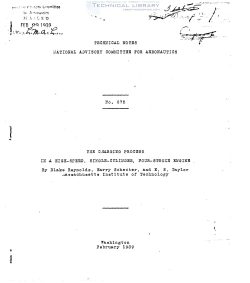naca-tn-675
- Version
- 145 Downloads
- 2.03 MB File Size
- 1 File Count
- November 28, 2016 Create Date
- November 28, 2016 Last Updated
National Advisory Committee for Aeronautics, Technical Notes - The Charging Process in a High Speed, Single Cylinder, Four Stroke Engine

Experimental measurements and theoretical calcula-
tions have been made on an aircraft—type, single—cylinder
engine, in order to determine the physical nature of the
inlet process, especially at high piston speeds. The en—
gine was run at speeds from 1,500 to 2,600 r.p.m. (mean_
piston speeds 1,870 to 2,380 feet per minute). Measure—
ments were made of the cylinder pressure during the inlet"
stroke, and of the power output and volumetric efficiency.
Measurements were also made, with the engine not running,
to determine the resistance and mass of the air in the in—
let—valve port at various crank angles.
A theoretical analysis of the process was made, on a
purely mechanical basis (no account being taken of thermal
effects). The results of this analysis indicate that, as
far as the mechanice is concerned, mass has an appreciable
effect but friction plays the major part in restricting
flow: '
From the pressure records it was found that the cylin—
der Was filled to very nearly atmosoheric re re’Efi ifir‘
tom_qenter, even at the highest speed. {Similar results
Were no e on a larger cylinder running at piston speeds
up to 2,750 feet per minute.) The observed fact that the _
volumetric efficiency is considerably less than lOOUper-
Cent is therefore attributed to thermal effects. An esti—
mate was made of the magnitude of these effects in the
present case, and their general nature discussed.
In connection with the analysis, it was necessary to
obtain accurate records of the absolute cylinder pressure.
Modifications of the M.I.T. indicator for this purpose are
described in an appendix.
The maximum powerteutput of an'ehgine is closely re—
lated to the quantity of air which it can pump. At.high
piston'speeds} this quantity'mayjbe.limited by the flow
characteristics of the inlet valve. Previous experimenters,
recognizing this.Limitation. have devoted-chnsiderahle ef-
fort to determine the characteristics of steady flow (ref—
erences 1, 2) and dynamic flow (references 3, 4, 5, 6)
through valves. Work has also been done (references 3, 7,
8, 9) on the effect of inlet pipes of various lengths on
the dynamics of air TIOW. This work has been largely de—
voted to engines Operating at lower piston-speeds.-and in—
formation relating,to.the flow in the_valve itself under
actual operating conditions is incomplete.
| File | Action |
|---|---|
| naca-tn-675 The Charging Process in a High Speed, Single Cylinder, Four Stroke Engine.pdf | Download |

Comment On This Post